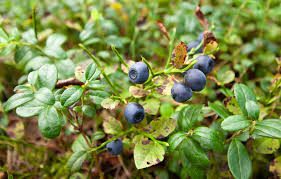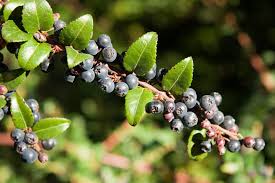Huckleberries, scientifically known as Vaccinium spp., are delightful little berries that grow on shrubs in various regions around the world. These small, round fruits are often celebrated for their unique taste and versatility.
In terms of appearance, huckleberries are typically small and range in color from deep red to purple or even black, depending on the specific species. The scientific name, Vaccinium, places huckleberries in the same genus as blueberries and cranberries, highlighting their botanical relationship.
Huckleberries thrive in diverse environments, from mountainous terrains to forests and even some coastal areas. Their adaptability contributes to their widespread distribution, making them a sought-after berry for foragers and enthusiasts alike.
One of the remarkable qualities of huckleberries is their rich flavor profile. These berries boast a perfect balance of sweetness and tartness, making them suitable for a variety of culinary applications. From jams and pies to sauces and beverages, huckleberries bring a burst of natural goodness to numerous dishes.
Beyond their culinary appeal, huckleberries also offer health benefits. Packed with antioxidants, these berries may contribute to overall well-being by helping to combat oxidative stress in the body. Additionally, huckleberries contain essential vitamins and minerals, further enhancing their nutritional value.
For centuries, indigenous communities have valued huckleberries not only for their taste but also for their medicinal properties. Traditional uses include remedies for digestive issues and skin conditions, showcasing the cultural significance of these berries.
Huckleberry picking is a popular outdoor activity, drawing people to the serene beauty of huckleberry patches. The process of handpicking huckleberries fosters a connection with nature and a sense of appreciation for the bounty it provides.
Huckleberries stand out as a delightful and versatile fruit with a rich cultural history. From their scientific name, Vaccinium spp., to their vibrant colors and distinct flavors, these berries continue to captivate people around the world. Whether enjoyed fresh, incorporated into culinary creations, or cherished for their health benefits, huckleberries remain a symbol of nature’s bounty and the joys of simple pleasures.
Read Also: Rabbit Health and Diseases and How to Minimize Major Stresses
The History of Huckleberries

The history of huckleberries is deeply rooted in the landscapes they inhabit, weaving a tale of cultural significance and natural abundance. Indigenous communities across various regions have long recognized and valued these berries, incorporating them into their traditional practices.
Native American tribes, particularly those in the Pacific Northwest and parts of North America, have a rich history of harvesting and utilizing huckleberries. For centuries, these berries played a vital role in the diets of indigenous peoples, providing a seasonal source of nutrition and flavor. The huckleberry harvest often became a communal activity, reinforcing social bonds within the community.
European settlers in North America also discovered the allure of huckleberries, adopting them into their culinary repertoire. Early pioneers, lacking access to familiar fruits from their homelands, embraced the unique taste and versatility of huckleberries, incorporating them into pies, jams, and other dishes.
As the years passed, huckleberries gained popularity beyond indigenous and local communities. Their distinct flavor and adaptability to various climates led to commercial cultivation, making them accessible to a wider audience. Today, huckleberries are celebrated not only for their historical significance but also for their culinary and health benefits.
Huckleberry festivals and events have emerged in regions where these berries are abundant, creating opportunities for people to come together and celebrate the harvest. These gatherings often feature huckleberry-themed dishes, showcasing the berry’s enduring appeal.
The conservation of huckleberry habitats has also become a focus in recent years, as awareness grows about the importance of preserving the ecosystems that support these beloved berries. Efforts to sustainably manage huckleberry populations highlight the interconnectedness between nature and human traditions.
In essence, the history of huckleberries is a narrative of cultural heritage, adaptation, and appreciation for the natural world. From indigenous practices to the integration into diverse culinary traditions, huckleberries continue to be a symbol of the enduring relationship between people and the bountiful landscapes they call home.
The Nutritional Values of Huckleberries
Huckleberries, with their small size, pack a punch when it comes to nutritional value. These berries are not only delicious but also offer a range of essential nutrients that contribute to overall well-being.
1. Antioxidants: Huckleberries are rich in antioxidants, including anthocyanins and quercetin. These compounds help combat oxidative stress in the body, potentially reducing the risk of chronic diseases.
2. Vitamins: Huckleberries are a good source of various vitamins, including Vitamin C, Vitamin K, and Vitamin B complex. Vitamin C, in particular, is known for its immune-boosting properties.
3. Minerals: Huckleberries contain essential minerals such as potassium, manganese, and magnesium. These minerals play crucial roles in maintaining proper bodily functions, including heart health and bone strength.
4. Dietary Fiber: Huckleberries are a good source of dietary fiber, promoting digestive health and aiding in weight management. Fiber also helps regulate blood sugar levels and contributes to a feeling of fullness.
5. Low in Calories: Huckleberries are relatively low in calories, making them a guilt-free addition to a balanced diet. Their natural sweetness can be a satisfying alternative to sugary snacks.
6. Natural Sugars: The sweetness of huckleberries comes from natural sugars, providing a tasty option for those looking to reduce their refined sugar intake.
7. Phytochemicals: Huckleberries contain various phytochemicals, which are compounds found in plants that may have health benefits. These phytochemicals contribute to the berry’s vibrant colors and may have protective effects on human health.
Incorporating huckleberries into your diet can be a flavorful way to enhance your nutritional intake. Whether enjoyed fresh, in jams, or as part of desserts and smoothies, these berries offer a tasty and healthful addition to a well-rounded eating plan.
Read Also: Rabbit Reproduction: Pregnancy, Kindling, Sexing, and Weaning
Health Benefits of Huckleberries

Huckleberries come with a range of health benefits, making them not only a delicious treat but also a nutritious addition to your diet. Here are some key health benefits associated with consuming huckleberries:
1. Antioxidant Power: Huckleberries are rich in antioxidants, particularly anthocyanins, which have been linked to reducing oxidative stress in the body. Antioxidants play a crucial role in protecting cells from damage caused by free radicals, potentially lowering the risk of chronic diseases.
2. Heart Health: The antioxidants and fiber in huckleberries contribute to heart health. They may help lower blood pressure, reduce inflammation, and improve overall cardiovascular function.
3. Immune Support: Huckleberries are a good source of Vitamin C, known for its immune-boosting properties. Regular consumption of Vitamin C may enhance the body’s ability to fight off infections and maintain a healthy immune system.
4. Digestive Health: The dietary fiber in huckleberries aids in digestion by promoting regular bowel movements and preventing constipation. Fiber also supports a healthy gut microbiome.
5. Bone Health: Huckleberries contain essential minerals like manganese and Vitamin K, both of which play roles in bone health. Manganese contributes to bone development, while Vitamin K is essential for proper blood clotting and bone mineralization.
6. Weight Management: The fiber content in huckleberries helps create a feeling of fullness, potentially assisting in weight management by reducing overall calorie intake.
7. Reduced Inflammation: Some compounds in huckleberries, such as quercetin, have anti-inflammatory properties. This may be beneficial in managing inflammatory conditions within the body.
8. Vision Protection: The antioxidants in huckleberries, particularly lutein and zeaxanthin, are associated with eye health. They may help protect against age-related macular degeneration and promote overall vision health.
It’s important to note that while huckleberries offer these health benefits, they are just one component of a balanced and varied diet. Incorporating a diverse range of fruits, vegetables, and whole foods is key to promoting overall health and well-being.
How to Grow Huckleberries (Growing Guide)
Growing huckleberries can be a rewarding experience, providing you with fresh, flavorful berries right from your own garden. Here’s a simple guide to help you grow huckleberries:
1. Climate and Soil: Huckleberries thrive in acidic soil with a pH level between 4.0 and 5.5. Ensure well-draining soil to prevent waterlogging. Choose a planting location that receives partial to full sunlight, as huckleberries generally prefer these conditions.
2. Planting:
Selecting Varieties: Choose huckleberry varieties that are well-suited to your climate. Common varieties include the evergreen huckleberry (Vaccinium ovatum) and the red huckleberry (Vaccinium parvifolium).
Container or Ground Planting: You can grow huckleberries in containers or directly in the ground. If using containers, ensure they have good drainage.
Planting Depth: Plant huckleberries at the same depth they were in their nursery containers. Space multiple plants at least 3 to 4 feet apart.
3. Watering: Keep the soil consistently moist, especially during the growing season. However, huckleberries are susceptible to root rot, so avoid waterlogged conditions.
4. Fertilizing: Apply a balanced, acidic fertilizer in spring before new growth begins. Follow the package instructions for the specific fertilizer you choose.
5. Pruning: Prune huckleberry bushes in late winter or early spring to remove dead or damaged branches. This helps maintain plant health and encourages new growth.
6. Mulching: Apply a layer of organic mulch, such as pine needles or wood chips, around the base of the plants. Mulching helps retain soil moisture and suppress weeds.
7. Pest and Disease Management: Keep an eye out for pests like aphids or spider mites. Insecticidal soap or neem oil can be used for control. Fungal diseases may occur, especially in humid conditions. Proper spacing, good air circulation, and avoiding overhead watering can help prevent these issues.
8. Harvesting: Huckleberries are ready for harvest when they reach their full color and easily detach from the stem. Harvesting is typically done in late summer to early fall.
Growing huckleberries requires patience and attention to detail, but the delicious reward of homegrown berries makes it well worth the effort. Enjoy the process of nurturing these plants and watching them flourish in your garden.
Read Also: Top 10 Vegetable Crops to Grow in Your Backyard
